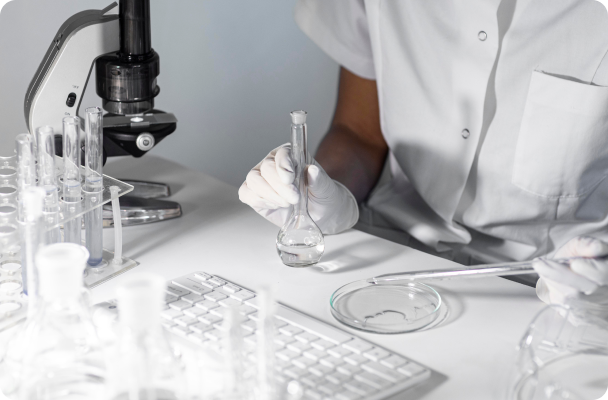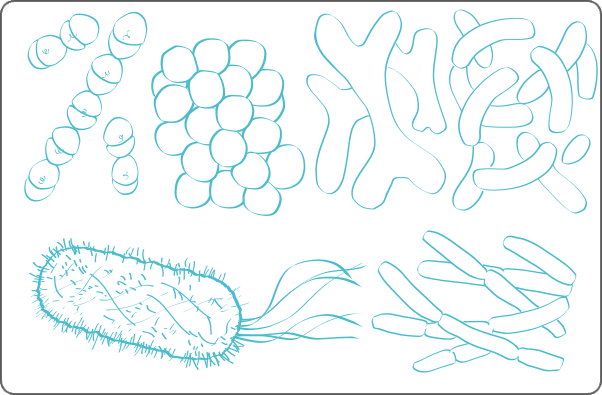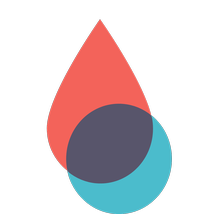Home › Biological sample › Infectious diseases › Other bacteria
Biological samples of bacterial infections
For research applications
The development of drugs and diagnostic tests for the treatment and detection of bacterial infections requires conducting studies on biological samples obtained from patients with bacterial infections.
Here's a brief overview of various infectious diseases caused by bacteria and how the service provided by Labtoo contributes to accelerating R&D projects in the pharmaceutical industry.


Are you looking for biological samples from patients with bacterial infections?
What are the different types of pathogenic bacteria?
Pathogenic bacteria, extending far beyond well-known ones like Escherichia coli and Streptococcus, represent a broad category of infectious agents. Their toxicity and modes of transmission vary, depending on multiple factors. The most frequently affected areas by bacterial infections include the respiratory tract (ENT, bronchi, and lungs), the gastrointestinal tract (from the stomach to the colon), and the urogenital system. Contamination routes can be airborne, through indirect contact with contaminated water or food, or direct contact with infected individuals. Furthermore, some pathogenic bacteria can be transmitted by biological vectors such as mosquitoes, ticks, flies, or fleas. A thorough understanding of these different transmission modes and the bacteria involved is essential for the prevention, diagnosis, and effective treatment of bacterial infections.
This page will be dedicated to listing some of the most common bacteria based on their mode of transmission

| Examples of Bacteria | Infection Domain | Commonly Associated Symptoms |
|---|---|---|
| Mycobacterium tuberculosis | Pulmonary | Persistent cough, fever, weight loss, fatigue |
| Neisseria gonorrhoeae | Urogenital | Purulent discharge, pain or burning on urination (men), abnormal vaginal discharge, lower abdominal pain (women) |
| Borrelia burgdorferi | Vector-borne (transmitted by ticks) | Erythema migrans (expanding red rash), fatigue, fever, joint pain (symptoms of Lyme disease) |
| Escherichia coli | Gastrointestinal | Diarrhea, abdominal cramps, nausea, vomiting |
Explore Labtoo's Service for Your Biological Sample Research
Labtoo assists you in sourcing biological samples from patients with bacterial infections. Our team manages the entire project of transferring biological materials from inception to sample delivery.
- Feasibility assessment of sample availability or clinical collection from referenced clinical centers
- Validation of regulatory aspects
- Establishment of a contractual framework
- Dispatch of desired samples under appropriate conditions
- Transfer of associated clinical data
- Additional analytical and experimental services
Types of available samples
Urine
In the context of bacterial urinary tract infection, a urine sample is collected to perform a cytobacteriological examination of urine (CBEU) in order to confirm the presence of the pathogenic agent. These samples can subsequently be preserved under appropriate conditions for future research projects.
Feces
In cases of gastrointestinal bacterial infection, the collection of fecal samples is crucial for identifying the pathogenic agent. These samples can also be preserved for further research on the behavior and characteristics of pathogenic bacteria.
Cerebrospinal fluid (CSF)
In the case of a nervous system infection, collecting cerebrospinal fluid (CSF) samples is necessary to identify the pathogen as well as its stage of progression. These samples can also be preserved for further research.
Other
Other types of samples such as nasopharyngeal, respiratory, or vaginal swabs are also commonly used in research on infectious diseases.
- Fresh Tissues: Dermal samples, such as wound or abscess specimens, are often collected to identify and study the presence of this pathogenic bacterium in skin infections.
- Frozen Tissues (OCT and FF)
- FFPE Tissues
- Whole blood: from patients with bacterial infection, particularly those who have developed bacteremia.
- PBMC (Peripheral Blood Mononuclear Cells)
- Plasma
- Serum
- Leukapheresis
Typical associated clinical data
-
- Age
- Gender
- Ethnicity
- Detection Method
- Serological result
- Bacterial Load
- Follow-up Treatment
- Simptomatology
- Medical Imaging
- Positivity/Negativity for certain Infections
- Other Data (upon request)

Labtoo identifies clinical sites that can prepare and transfer sample collections tailored to your specific project needs.
Contact our team to discuss your project.
Send your request to our team:
Respiratory Bacteria
Various bacteria are capable of infecting the upper respiratory tract (sinuses, pharynx, and larynx) and lower respiratory tract (trachea, bronchi, and lung parenchyma), leading to various clinical conditions such as bronchitis, pneumonia, rhinopharyngitis, otitis media, sinusitis, or tonsillitis. They can also exacerbate respiratory difficulties in individuals with respiratory problems such as bronchopneumopathy or asthma.
These bacteria are typically transmitted through direct contact with airborne droplets from sneezing by infected individuals. Indirect transmission can also occur through inhalation of droplets from contaminated water, for example from poorly maintained cooling towers or air conditioners.
Treatment varies depending on the site of infection. For example, since bronchial infections are often of viral origin, the use of antibiotics is discouraged if the infectious origin is not fully certain.
Among these bacteria are:
Mycoplasma pneumoniae
Responsible for atypical pneumonia, a typically benign but potentially severe illness in infants or individuals with underlying health issues.
Symptoms include a dry, persistent, non-productive cough, sore throat, mild to moderate fever, headaches, fatigue, and sometimes muscle aches.
Mycoplasma pneumoniae is an atypical bacterium due to its lack of a cell wall, making it resistant to many common antibiotics.
Legionella pneumophila
Bacterium responsible for Legionnaires' disease, a potentially serious pulmonary infection in humans.
It thrives in aquatic environments (air conditioning systems, cooling towers...) and can be inhaled in aerosol form.
Symptoms include high fever, chills, headaches, muscle pains, dry cough, and respiratory difficulties, with possible complications in vulnerable individuals.
Moraxella catarrhalis
A common bacterium in humans, often associated with respiratory conditions such as sinusitis, bronchitis, and pneumonia.
It is pathogenic, especially in the elderly, children, and individuals with chronic lung diseases.
Symptoms include persistent cough, often accompanied by purulent sputum, chest pain, fever, nasal congestion, and sore throat.
Intestinal bacteria
Among intestinal infections, in addition to infections with pathogenic Escherichia coli, various bacteria can cause diarrhea of varying severity accompanied by abdominal pain. Some of these bacteria have the ability to produce toxins that can affect various organs of the body.
Transmission of these bacteria mainly occurs through ingestion of contaminated water or food. Pathogenicity can result from the bacteria itself or the toxin it produces. Additionally, transmission can also occur through direct contact with contaminated individuals.
Treatments vary depending on the bacterial species, the location of the infection, and its severity. However, antibiotics combined with antidiarrheals are often prescribed. It is also recommended to maintain good hydration and rest the intestines by avoiding heavy foods.
Among the pathogenic bacterial species of the intestinal tract are:
Salmonella spp
It is responsible for salmonellosis, this bacterium adheres to the cells of the intestinal mucosa, causing damage and disruptions to intestinal function.
It is commonly associated with ingestion of contaminated foods such as meat, eggs, dairy products, or vegetable-based products.
Campylobacter jejuni
Often associated with the consumption of contaminated poultry meat or untreated water, this bacterium can cause gastrointestinal infections, sometimes severe in young children or immunocompromised individuals.
Clostridium
This genus includes several pathogenic species producing potentially deadly toxins.
For example, Clostridium difficile can cause severe intestinal disorders in people on antibiotics.
Clostridium botulinum, on the other hand, produces a neurotoxin responsible for botulism, a potentially deadly paralytic disease.
Vibrio cholerae
Responsible for cholera, this bacterium causes severe watery diarrhea due to an over-secretion of intestinal fluid induced by a specific toxin, the cholera toxin. It is mainly transmitted through the ingestion of water or food contaminated with fecal matter.
Listeria monocytogenes
This bacterium can cause listeriosis by crossing the intestinal barrier and invading the body's tissues, leading to serious infections such as meningitis or septicemia.
It is often found in unpasteurized dairy products.
Urogenital infection
Urogenital infections result from the pathogenic activity of various bacteria, which can affect the genital organs, the urinary system, or other parts of the urogenital system.
The most common symptoms include abnormal genital discharge, pain during urination, itching, pain during sexual intercourse, or localized rashes in the genital area. Transmission of these infections can occur through several vectors, but the most common is transmission through unprotected sexual intercourse, often making them sexually transmitted infections (STI).
Among the most common pathogenic urogenital bacterial species are:
Neisseria gonorrhoeae
Causing gonorrhea, this bacterium infects the mucous membranes of the genital organs, anus, and sometimes the throat. In men, typical symptoms include purulent discharge from the penis, pain or burning during urination, and testicular pain.
In women, they may include abnormal vaginal discharge, lower abdominal pain, and bleeding between periods. Untreated gonorrhea can lead to serious complications by spreading to other parts of the body such as the joints, skin, heart, and nervous system.
Chlamydia trachomatis
Responsible for chlamydia, this bacterium infects the cells of the genital mucosa, causing local inflammation.
The most commonly affected areas are the cervix in women and the urethra in men. It can be asymptomatic, complicating its diagnosis, but common symptoms include pain during urination, lower abdominal pain, and bleeding between periods in women, as well as testicular swelling in men.
Without treatment, chlamydia can lead to complications such as pelvic inflammatory disease in women or urethritis in men, and potentially infertility.
Treponema pallidum
The causative agent of syphilis, this bacterium primarily infects the genital organs but can also affect other parts of the body.
The infection progresses through several stages: The first stage is characterized by the appearance of a painless chancre at the site of infection, often on the genital organs, anus, or mouth.
The second stage involves a skin rash, mucosal lesions, and swollen lymph nodes.
Without treatment, the infection can progress to the tertiary stage, causing serious damage to internal organs, the nervous system, and the brain.
Vector-Borne bacteria
Vector-borne bacteria are pathogenic agents transmitted to humans by biological vectors such as ticks, fleas, or mosquitoes. The severity of infections varies depending on the pathogen involved as well as the host's immune response.
Although the diseases they cause have specificities unique to each species, some common symptoms include elevated body temperature, headaches, fatigue, as well as muscle and joint pain.
Among the pathogenic bacteria transmitted by vectors are:
Borrelia burgdorferi
This bacterium is commonly transmitted through tick bites and is responsible for Lyme disease.
Symptoms of this disease can vary among individuals and stages of infection. In its initial phase, it is often characterized by a skin rash called erythema migrans, accompanied by fever, fatigue, headaches, and muscle and joint pains.
Without treatment, it can progress to more advanced forms, leading to neurological, cardiac, joint, and cutaneous complications. Early treatment usually cures the disease, while complications arise in the absence of initial treatment.
Rickettsia rickettsii
Transmitted by ticks, this bacterium is responsible for Rocky Mountain spotted fever, a disease characterized by fever, skin rashes, and joint pains.
Rickettsia typhi
Transmitted by fleas, this bacterium is responsible for murine typhus.
This disease presents with fever, skin rashes, and joint pains, which can lead to serious complications such as pulmonary and cardiac involvement.
Without treatment, the infection can progress to the tertiary stage, causing serious damage to internal organs, the nervous system, and the brain.



